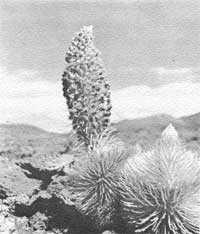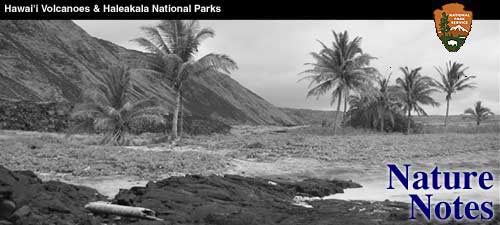|
HAWAII NATURE NOTES
THE PUBLICATION OF THE
NATURALIST DIVISION, HAWAII NATIONAL PARK
AND THE HAWAII NATURAL HISTORY ASSOCIATION
|
AHINAHINA OR SILVERSWORD
Argyroxiphium macrocephalum—Sunflower Family (Compositae)
|
|
No plant in Hawaii, and few elsewhere, is more
spectacular than the silversword. The visitor to Haleakala crater will
see this beautiful plant with its silvery, sun-reflecting leaves,
growing on the cinder cones and in the silversword area near the summit.
A member of the composite or sunflower family, it blooms but once from a
tall stalk. The entire plant dies after blooming. The flowers have
lavender petals which are grouped around brown seeds. The silversword
once occupied a much greater range than it does now. This same species
formerly was abundant on the slopes of Mauna Kea, Hualalai, and Mauna
Loa. Many more once grew in Haleakala crater than are to be seen there
now, but the present population has been estimated to be more than
20,000 plants. Several factors have been instrumental in decreasing the
silversword. Thousands were uprooted by man before Hawaii National Park
was formed. Degener lists six insects which are more or less injurious.
The domestic goat, introduced by the explorers and now running wild over
many of the islands, eats the young flower buds, thus destroying the
seeds as they are forming. Control measures are being taken against
these pests.
|

Silversword. TARLETON
|
|

Silverswords growing on a cinder cone, Ka Moa o Pele (The Chicken of Pele), Haleakala Crater. McCALL

Railliardia in Haleakala Crater. TARLETON
|
|
KUPAOA OR RAILLIARDIA
Railliardia sp.—Sunflower Family (Compositae)
|
|

Railliardia laxiflora (top), Railliardia scabra
(bottom) (Inch squares on backgrounds)
|
Several members of the Railliardia group are
in Hawaii National Park. They are of the sunflower family but grow only
in the Hawaiian Islands. The plants illustrated are Railliardia
laxiflora and R. scabra. They are among the most common
Railliardia to be seen in the vicinity of Kilauea. Within
Haleakala crater and on its slopes, at least three other kupaoa
may be found. The Hawaiians used the fragrant root of this plant to
perfume their tapa, or bark cloth, and their featherwork.
The seeds are dispersed by the wind.
|
|

